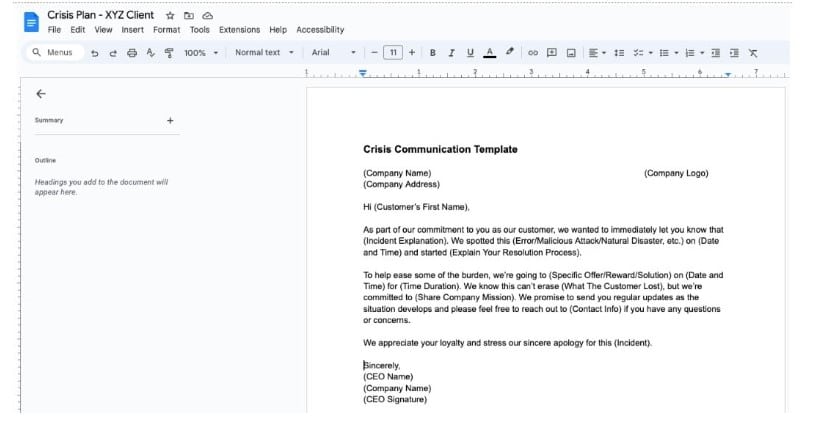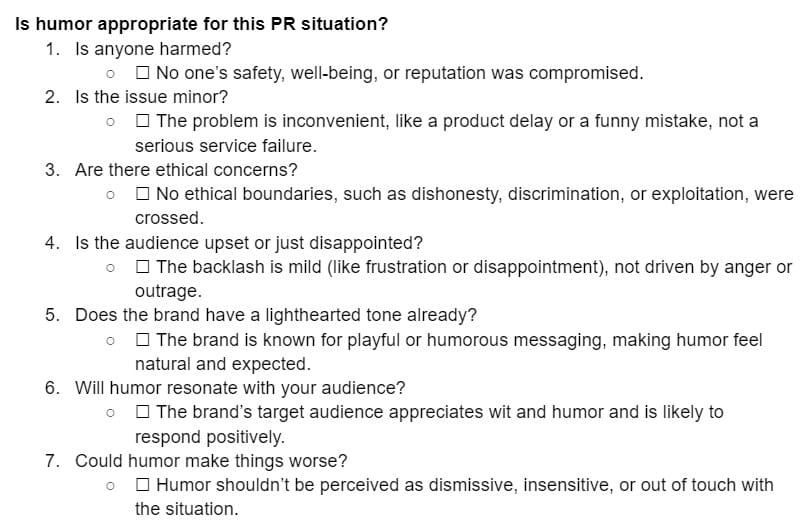One of the top skills you can have as a PR rep? Using bad publicity or negative perceptions to create an opportunity for success is especially important in a digital-first world where brands are more vulnerable than ever to public scrutiny and social backlash.
Whether you’re helping one of your PR clients put out a fire—or taking on a new business in a negatively perceived industry—you need to know how to change the narrative.
Let’s take a closer look at some positive branding and marketing strategies for transforming setbacks and negative perceptions into PR success stories.
Strategy 1: Be transparent and take ownership
When negative branding hits, your first instinct might be to deflect — but this approach can backfire fast.
The best response? Total transparency.
Have your client be honest about what went wrong and take full ownership of the situation. Audiences appreciate honesty, which is the first step toward rebuilding their trust.
For example, imagine you’re working with a food brand that recently had a product recall due to contamination concerns. Instead of going silent or downplaying the issue, the brand can immediately issue a statement acknowledging the mistake, apologizing sincerely, and outlining the steps to resolve the problem.
Then, it can use social networks to keep the conversation going. They’ll need to provide real-time updates on their safety measures and preventive actions.
This builds credibility and shows potential customers that the brand takes their concerns seriously.
Strategy 2: Reposition the narrative around the brand’s strengths
Sometimes, negative branding stems from outdated perceptions or misconceptions. In this case, a great way to flip the script is by repositioning the narrative and highlighting the company’s strengths.
Consider the brand Hers, a telehealth company that offers wellness products and anxiety medication. Rather than shy away from the stigma associated with mental health, Hers leaned into the conversation and made mental health support accessible.
The marketing team reframed a potential liability into a strength by focusing on its commitment to destigmatizing mental health care. It used its content to emphasize the importance of seeking help and remove fear from the equation. The brand also brought in celebrities to talk about their experiences with anxiety medication, advocating against the stigma of mental health.

You can help your PR clients do something similar by finding areas where they’re strong and shifting the conversation to emphasize those qualities.
For example, if a brand is criticized for poor service, showcase testimonials from satisfied customers or highlight changes made to improve the customer experience. Or use brand advocates like Hers does. (More on this in a bit.)
This can help the audience focus on what the brand is doing “right”—instead of punishing it with public ridicule or bans.
Strategy 3: Use storytelling to connect emotionally
People remember stories more than statistics.
If you want to improve a poor branding experience, connect emotionally with the audience through a narrative they can relate to and support.
For example, imagine you’re working with a company in a negatively perceived industry, like fast fashion (which often gets a negative image for its environmental impact). Crafting a new story highlighting the brand’s commitment to sustainability is one way to help change the perception.
For instance, you could document real stories of workers who benefit from fair wages and how the company sources sustainable materials. You could then share these across the brand’s social networks, website, and sales landing pages.
Storytelling works because it goes beyond stone-cold business transactions.
It taps into human emotions and values, which positions the brand as “aspirational” instead of just another product or service.
Strategy 4: Encourage leadership development to build resilience
A brand’s leadership can make or break how well it navigates negative branding.
When executives have the right leadership skills, they can communicate effectively, reposition narratives, and guide the company out of a PR crisis with confidence.
This is why leadership development is so important.
Consider a tech company facing backlash over data privacy concerns. If the company has a strong leadership team, they’ll act swiftly to help rebuild customer trust. That may mean immediately communicating an action plan, like launching a new security feature to protect user data. They could also ensure that key decision-makers are available through appointment-setting tools, allowing customers or stakeholders to connect directly with leadership for reassurance and clarity.
To help your clients build resilience, encourage them to invest in leadership training programs that focus on:
- Transparent communication
- Crisis management
- Team-building skills
Be sure to also supply them with scripts and templates that can help them speed up the communication process. While they’ll always lean on you for major crisis management support and other PR needs, empowering your clients with tools they can use themselves is important.

This helps you set them up for success—and gives them some support aids to act fast on their own in case you’re busy or on vacation.
Strategy 5: Turn customer feedback into fuel for growth
Negative comments and feedback aren’t something to shy away from. In fact, it can be a goldmine for improvement.
One of the most powerful ways to flip negative branding is by treating customer complaints as constructive feedback (and making tangible changes based on it).
For example, a tech company facing backlash over a buggy product release could launch a marketing campaign thanking users for their feedback and announcing a major product update that addresses the issues. By incorporating email campaign management, the company could ensure personalized updates directly reach affected customers, demonstrating the brand’s commitment to listening and improving.
It also demonstrates that the brand is adaptable and open to growth—even if it means addressing its own flaws.
This goes back to transparency. Transparent brands feel authentic to audiences (which, again, helps build trust). The higher the trust, the better the brand image.
Speaking of trust …
Strategy 6: Use influencers and brand advocates to shift perceptions
Sometimes, the best way to turn negative branding around is by getting trusted voices to speak on the brand’s behalf.
Influencers and brand advocates have powerful sway over public opinion. When they support a brand, it can help erase negative perceptions.
Let’s say a beauty brand has faced criticism for a poor environmental track record. It could partner with influencers known for promoting sustainable practices. The influencers could share the brand’s updated eco-friendly initiatives (like its ethical and low-impact ingredients) and vouch for its improvement efforts.
Loyal customers can also become brand advocates by sharing their positive experiences on social networks. This is also known as user-generated content (or UGC).
Using UGC across marketing and PR campaigns adds another layer of authenticity to a brand’s digital presence. This can help offset bad branding in a more natural and relatable way.
In other words, when you work with influencers and advocates, you’re not just flipping the script—you’re handing the megaphone to people the audience already trusts.
Strategy 7: Use humor to soften the blow
When the branding issue isn’t overly serious (think minor customer complaints or product missteps that don’t involve safety or integrity), you can use humor to turn things around.
By poking fun at themselves or using lighthearted messaging, brands can show they’re not only aware of their mistake but also relatable and approachable.
This makes the brand feel more human and can diffuse tension.
For example, let’s say a fast-food chain has a blunder where they accidentally run out of fries during a busy promotion. Instead of going radio silent or offering a stiff apology, it could use humor to own the situation.
A witty social media post might say, “Looks like we got a little fried up! 🍟 Who knew you all loved fries this much? We’re working on a fresh batch now — stay crispy and come back soon!” Light-hearted messaging can quickly turn an inconvenience into a memorable, shareable moment.
You can also combine humor with visual elements (think funny memes, playful videos, or GIFs) on social networks. This softens the blow and encourages engagement since potential customers are likelier to share something funny and relatable than a corporate apology.
But …
If the brand deals with something more significant, like ethical concerns or a serious service failure, humor can backfire. So, be sure to know when to use it — and when to choose a more serious tone.
If you’re not sure, use the following checklist:

If you’ve checked all of the above boxes, try humor!
Wrap up
Every PR setback is an opportunity to strengthen your client’s brand and re-establish trust with its audience.
With a growth mindset like this—and the strategies we covered in this article—you can transform even the toughest PR challenges into success stories.
For more tips and insights on managing brand perception, check out the Agility PR Solutions Resource Center. And if you’re looking to connect with journalists, get coverage, or monitor media mentions, check out our AI-powered PR tools and services here.
To your success!








